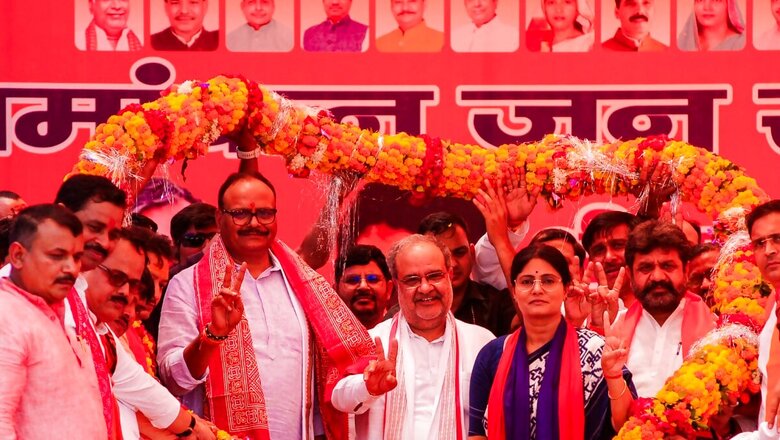
226
views
views
Anupriya Patel is described as an accessible leader, facing limited anti-incumbency. A slew of development work in the constituency is credited to her. Moreover, her husband, Ashish Patel, is a minister in the CM Yogi Adityanath-led state cabinet, and has formed deep connections with the people of Mirzapur
The Mirzapur Lok Sabha constituency, one of the 80 parliamentary constituencies in Uttar Pradesh, is a General category seat encompassing the entire Mirzapur district. It currently includes five Legislative Assembly segments: Chhanbey (SC), Mirzapur, Majhawan, Chunar, and Marihan, all of which are held by the BJP-led NDA.
Current MP: Anupriya Singh Patel (Apna Dal-S) since 2014, preceded by Bat Kumar Patel of Samajwadi Party (2009)
Candidates: Anupriya Singh Patel (Apna Dal-S), Ramesh Bind (SP), Manish Tripathi (BSP)
Polling Date: Phase 7, June 1, 2024
Political Dynamics
- BJP Ally on the Driver’s Seat: Mirzapur has played a crucial role in the political careers of prominent figures such as Defence Minister Rajnath Singh and Rajya Sabha MP Arun Singh. In 1996, Phoolan Devi made history as the first woman MP from Mirzapur. In 2024, Bharatiya Janata Party’s ally Apna Dal (Soneylal) is commanding a sharp edge against the Samajwadi Party and the Bahujan Samaj Party.
- Apna Dal (S) has fielded its incumbent MP Anupriya Patel from the Mirzapur constituency to fight for a third consecutive term. Patel is a former teacher and social worker who joined the party in 2016, and currently serves as the Minister of State for Commerce and Industry. She was formerly the MoS for the Union Health Ministry and has also served as an MLA from Rohaniya.
- Two-time MP Anupriya Singh Patel has been holding the seat since 2014, winning it in 2019 with a massive margin of 2.32 lakh votes and maintaining her 2014 lead of 2.19 lakh votes. In 2019, the SP and the BSP were in alliance, with the SP fielding Ramcharitra Nishad, who bagged 32.42% of the vote against Anupriya’s 53.34%. Meanwhile, the Congress also bagged a sizeable number of votes with 8.25%.
- The Apna Dal, founded by Sonelal Patel in the early 90s, split into two factions following his death. One faction, Apna Dal (Sonelal), was established in 2016 by Sonelal’s daughter and Union Minister Anupriya Patel. This faction is allied with the BJP at both the central and state levels and has 13 MLAs in the state.
- Patel is described as an accessible leader, facing limited anti-incumbency. A slew of development work in the constituency is credited to her. Moreover, her husband, Ashish Patel, is a minister in the CM Yogi Adityanath-led state cabinet, and has formed deep connections with the people of Mirzapur.
- Her core vote is that of the Patels, who form a massive share of the electorate in Mirzapur, with roughly around 3.5 lakh votes. Her campaign is going steadily, with the Patel leader campaigning in other parts of the state as well for Apna Dal and the BJP.
- In Mirzapur, the Patel has an edge for several reasons including limited anti-incumbency, no alliance between rivals SP and BSP dividing the opposition vote share, and favourable caste equations in. With 3.5 lakh votes, Patels are expected to lean strongly towards Patel. Brahmins, Vaishyas and Kshatriyas forming over 3.9 lakh votes are also with the BJP for the most part.
- Certain challenges remain, however, as the BSP has fielded Manish Tripathi, a Brahmin candidate in the fray, which may trigger a minor split in the Brahmin vote. Bind voters, who account for about 1.5 lakh votes, are partly drawn to Ramesh Bind of the SP. Meanwhile, Dalit voters including a sizeable Kol community and OBC voters are split primarily in the BJP’s favour, which is a plus point for Patel. She will also receive a slim portion of Muslim votes as far as ground-level observations go.
- Moreover, the BJP and its allies Apna Dal and Nishad party hold all five seats in the constituency, dominating the Assembly polls in 2019. Notable leaders such as Apna Dal’s Rahul Prakash Kol from SC-reserved Chhanbey, Nishad party’s Vinod Kumar Bind from Majhawan and Ratnakar Mishra from Mirzapur, help balance caste equations for the BJP.
- The Modi factor is certainly a powerful phenomenon that Patel will be cashing in on as polling day gets closer. The prime minister’s scheduled rally is expected to raise the tide drastically in Patel’s favour. The popularity of the prime minister stems from national issues and Hindutva in cities, and welfare schemes in rural areas, including free ration and Awas Yojana which have had a significant impression on the ground.
- Meanwhile, the popularity of the chief minister has also given a solid edge to the party against its opponents. With the Yogi factor on the rise, owing to matters of development, Hindutva and improved law and order, the BJP unit finds itself positioned amid favourable conditions. The concept of a double-engine government has been marketed effectively in Mirzapur, with a visible political impact.
- SP Banks on Ex-BJP Man: The Samajwadi Party has named ex-BJP MP form Bhadohi, Ramesh Bind, as its candidate from Mirzapur. This selection did not come without a controversy, however, as the party had initially named Rajendra Bind and in a few weeks reneged its decision only to place a BJP turncoat in the race.
- Ramesh Bind was not re-nominated by the BJP, which had had conducted an internal survey to reportedly find that he was not favourably positioned for a ticket. In his stead, the BJP selected Majhawan MLA Vinod Kumar Bind as its candidate, which led to Ramesh Bind’s departure from the party, and a change in SP’s decision in Mirazpur.
- With Bind now contesting for the SP, the primary contest in Mirzapur is between two MPs. Bind is a former three-time MLA from Majhawan seat in Mirzapur, and was expelled from the BSP in 2019, after which he joined the BJP and attained a Lok Sabha ticket for the Bhadohi seat. He is a prominent leader from the Bind community, which comprises about 1.5 lakh votes in the constituency. With this, SP hopes to strategically snatch the Bind vote from the BJP. However, Bind is a controversial figure, seen as verbally aggressive in politics and having been accused of hate speech as well as making questionable remarks against the Brahmin community.
- Meanwhile, the BSP has named Manish Tripathi, a Brahmin face who is expected to divide the Brahmin vote which generally stands with the BJP. With Bind in the fray, however, there is considerable discontentment in the Brahmin community, which may orient itself to one side to ensure his loss.
- Electorally, the SP, backed by the Congress which bagged over 91,000 votes in the 2019 general elections, hopes to bank on the Muslim-Yadav vote consolidation. Muslims comprise roughly about 1.5 lakh votes, while Yadavs form another 1 lakh. Meanwhile, the party also hopes that with the selection of Ramesh Bind, the 1.5 lakh strong Bind community will be drawn to it. Infighting within the SP may cause obstacles in this vote consolidation.
- While Bind carries out a door-to-door campaign raising issues like inflation and unemployment, the INDIA alliance’s campaign is yet to take off in full throttle with a much anticipated Akhilesh Yadav rally expected shortly before polling day.
- All in all, while Anupriya Patel’s vote margin may narrow down partially, she is headed for a comfortable victory nonetheless, with the last few days of campaign being crucial in this battle.
Key Issues
- Unemployment: Unemployment is a major concern in Mirzapur. While small scale industries such as carpet, petal, and ceramic toys industry exist in the region, it is unable to keep up with increasing demands of employment opportunities in the region. Therefore, people are demanding the setup of big industries and industrial hubs in the region as the region is abundant in mineral resources. While more than Rs. 81000 crore in investments have been pledged, work is yet to start. Farming is not as attractive as it used to be as the youth wish to upgrade their standard of living. As a result the people, especially the youth, leave Mirzapur for Varanasi, Kanpur, Lucknow or Delhi.
- Traffic Issues: Mirzapur is an expanding city with a rising population, however, the city’s road infrastructure has failed to keep pace with the rising population. There has also been a considerable rise of private vehicles in the region that has increased congestion. Apart from that, issues regarding to lack of parking spaces, encroachment of roads by hawkers and illegal stops by buses and autos in the middle of the street has increased traffic issues. In addition, Mirzapur is an old city with many narrow lanes and streets which makes it difficult for two way traffic to ply on, however, people lack the basic civic sense and the traffic management in the city has remained below par.
- Health Infrastructure: Mirzapur faces challenges in healthcare despite the presence of infrastructure and a medical college. Healthcare centers frequently operate without a doctor or nurse, highlighting a significant shortage of medical professionals. Some healthcare centres in the rural areas are run solely by pharmacy staff who have no proper health education, putting the life of the patients at risk. While advanced equipment is available, patients are often referred to other hospitals due to staff unavailability, creating substantial inconvenience. The issue is compounded by doctors dividing their time between public clinics and private practices, impacting the quality of care available in public healthcare facilities.
- Educational Infrastructure: There are many colleges in Ghazipur providing higher education but none are up to standard. Students have complained about the regular absence of professors. Classes are not taken on time and students have rued about the lack of infrastructure at colleges. As a result many students pursuing higher education move to Delhi, Varanasi, Allahabad or Kanpur for better educational institutes in these regions.
- Agriculture Issues: There are many agricultural issues in the region, the biggest being the lack of assured irrigation facilities. Almost 60% of farmers rely on rain fed irrigation which leads to greater chances of crop failure.
- Crop failure leads to increasing debt burden on the farmers which is exacerbated by the lack of or delay in compensation. Increasing cost of agricultural production such as rising electricity costs, and the unavailability of pesticides and fertilizers at government supplied rates has also creeped up on the profit of farmers.
- While some farmers have relied on Organic farming to increase profits, the risk of crop failure cannot be borne by the small and poor farmers over and over. Another major issue in rural agriculture areas is the complexity of procedures in selling to the government. As a result, most small and medium farmers often sell their produce to local traders at significantly lower rates.
- Welfare Schemes: The impact of welfare schemes, particularly the PM Awas Yojana and CM Samuhik Vivah Yojana, is anticipated to be a significant factor in the upcoming Lok Sabha elections. As of December of last year, 381 couples, categorized as Scheduled Caste, Scheduled Tribe, Other Backward Class, Minority Category, and General Category, participated in the CM Samuhik Vivah Yojana, with 211 couples married at a single event.
- Statewide, the scheme has reportedly benefited a total of 3644 couples. Even the Jal Jeevan mission has been implemented successfully as people of the Lahuria Dah village are receiving piped water in their homes for the first time since independence.
Voter Demographics
- Urban Voters: 14.8%
- Rural Voters: 85.2%
- Literacy Rate: 57.22%
- SC: 26.1%
- Hindu: 92%
- Muslim: 7.84%
Infrastructure Development
- Mirzapur Bypass: Gadkari announced the construction of a bypass in Mirzapur in March this year. This is a welcome step which would help divert the highway commuters to avoid the traffic congestion in the city. The bypass will have 4 lanes.
- Upgradation of NH 35: The repair and upgradation of the Mirzapur-Prayagraj section of NH 35 is underway. It will help improve the speed of connectivity between the regions.
- Ganga Overbridge: Along with the bypass, Gadkari had also announced the construction of a 6 lane Ganga overbridge which will be built parallel to the Shastri Bridge on the Ganga. The construction of the overbridge along with the bypass and the upgradation of NH 35 is being done at a total cost of Rs 1,750 crore.
- Mirzapur-Ayodhya Corridor: The Mirzapur-Ayodhya Corridor, with bypass roads for two key cities, promises substantial logistical efficiency and reduced travel time. The corridor aims to enhance connectivity to the Varanasi Multi-Modal Terminal, fostering a shift towards. The corridor is still in the planning stage.
- Railway Infrastructure: The construction of new stations, renovation of existing ones, and upgrading platforms at various stations has been done. Additionally, work was completed on new foot over bridges, level crossings, and road over bridges. The railway lines were upgraded, and new tracks were laid, including the provision of signalling systems, electrification, and automatic stations. Furthermore, safety measures like provision of shelters and water supply systems were implemented. The overall aim was to improve connectivity, safety, and comfort for passengers.
Explore in-depth coverage of Lok Sabha Election 2024 Voter Turnout, Upcoming Phase, Results Date, Exit Poll And Much More At News18 Website
















Comments
0 comment